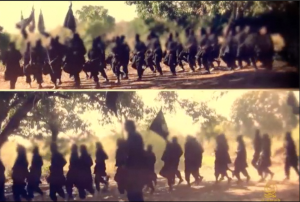The State Department today added two senior officials in Shabaab, al Qaeda’s official branch in East Africa, to the US government’s list of designated terrorists.
One of the two, Ahmed Diriye, is Shabaab’s overall leader. Diriye rose to that position after Ahmed Abdi Godane, Shabaab’s previous head, was killed in a US airstrike in September 2014. Shabaab quickly reaffirmed its allegiance to al Qaeda leader Ayman al Zawahiri after Diriye, who is also known as Sheikh Ahmad Umar and Abu Ubaidah, was named as Godane’s successor.
In its announcement today, State notes that Diriye “shares Godane’s vision for al Shabaab’s terrorist attacks in Somalia as an element of al Qaeda’s greater global aspirations.” Godane and al Qaeda publicly announced their merger in February 2012, but declassified documents recovered in Osama bin Laden’s compound, as well as other evidence, show that the two had a close working relationship well before then.
Shabaab remains openly loyal to Zawahiri despite recent suggestions that the group is going to leave al Qaeda’s ranks and join the Islamic State. Propaganda videos released by the terrorist organization this year are littered with images of Zawahiri and other senior al Qaeda leaders.
The State Department provides some biographical details on Diriye. “Prior to replacing Godane, Diriye served in several positions within Shabaab, including as Godane’s assistant, the deputy governor of Lower Juba region in 2008, and Shabaab’s governor of Bay and Bakool regions in 2009,” State notes. “By 2013, he was a senior adviser to Godane, and served in Shabaab’s ‘Interior Department,’ where he oversaw the group’s domestic activity.”
The other Shabaab leader designated today is Mahad Karate, who is also known as Abdirahim Mohamed Warsame. Karate, according to State, “played a key role in the Amniyat, the wing of Shabaab responsible for the recent attack on Garissa University College in Kenya that resulted in nearly 150 deaths.”
State describes the Amniyat as Shabaab’s “intelligence wing, which plays a key role in the execution of suicide attacks and assassinations in Somalia, Kenya, and other countries in the region, and provides logistics and support for Shabaab’s terrorist activities.”
Shabaab’s Amniyat
As The Long War Journal has previously reported, the UN National Security Council’s Monitoring Group on Somalia and Eritrea has provided numerous details on Shabaab’s Amniyat. That UN has also described Karate as the “deputy” to Shabaab’s emir.
In a report prepared in 2013, the UN said the “Amniyat combines a wide range of responsibilities, ranging from intelligence gathering and counter-intelligence to clandestine and special operations.”
“The structure of the Amniyat is understood” to include the following, according to the UN: “Central command, Regional commanders; Finance and logistics support units; Intelligence collection units; Grenade attacks/assassination squads; and Suicide operations squads.”
The UN explained that the Amniyat was responsible for protecting Shabaab’s emir, and ensuring that he remains in power against both internal rivals and external enemies.
The UN also provided some insider details about the Amniyat. In particular, the UN identified a “50-year old Sudanese national” known as “Hassan,” who serves “as a senior training instructor for Shabaab and who claimed to be formerly with the Sudanese military.” Hassan’s other aliases include “Jimale,” “Yusuf” and “Abdi Madobe.”
The UN’s sources say Hassan was “specifically tasked by” Ayman al Zawahiri, al Qaeda’s emir, “to train in Somalia African jihadists who are unable to travel to Afghanistan and Pakistan.” Hassan was “reportedly in contact with al Qaeda operatives as well as Godane in order to plan training strategies and programmes for Shabaab and other al Qaeda affiliates in Africa.”
Hassan also reportedly supervises “a training camp in South Sudan, at the border with Kenya, and left Somalia for Nigeria with a group of Boko Haram fighters after the completion of their training in March 2011.” A former Amniyat member told the UN that a Nigerian, and “several Yemenis, Kenyans and Ethiopians,” were “acquainted with” Hassan.
A follow up report by the UN in 2014 contends that Shabaab has been relying more heavily on the Amniyat to expand the group’s reach.
Shabaab’s “overt regional strategy has relied increasingly on its entrenched support base of Amniyat-like operatives,” the UN found. “By the end of 2013, its regional strategy had become apparent: a resurgent extremist group sufficiently assertive to fully align itself with and pursue strategies adapted to transnational [al Qaeda] operations, evident in its ability to conduct ‘complex and spectacular’ large-scale attacks, such as that on the Westgate shopping mall in Kenya, representing an evolution of operational tradecraft.”
The attack on the Garissa University College in Kenya earlier this month is consistent with the “regional strategy” identified by the UN.
The US has repeatedly targeted the Amniyat’s leadership in airstrikes. In March, the US killed Adan Garaar, a senior Amniyat official, in a drone strike. Two other Amniyat leaders, Yusuf Dheeq and Tahlil Abdishakur, were killed in US airstrikes on Jan. 31, 2015 and Dec. 29, 2014, respectively. [See LWJ reports: Somali government reports Shabaab’s intel chief killed in US airstrike; US military confirms it killed Islamic State, Shabaab leaders in airstrikes; and US confirms Shabaab intelligence official killed in drone strike.]








